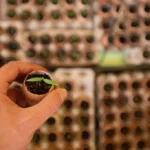In the intricate world of insects, thrips occupy a tiny yet impactful niche that often escapes the casual observer’s notice. These minuscule creatures, barely visible to the naked eye, are part of a diverse order known as Thysanoptera. While they may lack the charismatic charm of butterflies or the menacing reputation of certain garden pests, thrips have carved out a place in the natural tapestry, both for their ecological role and their occasional role as agricultural adversaries. In this exploration, we delve into the world of thrips, shedding light on their often-overlooked existence and, in particular, their ability to take to the skies in flight.
The World of Thrips
To comprehend the significance of thrips’ ability to fly, we first need to acquaint ourselves with these diminutive insects. Thrips, often measuring a mere fraction of an inch in length, possess unique characteristics that set them apart within the insect kingdom. They sport elongated bodies, fringed wings, and rasping mouthparts, which they use for feeding on plant tissues. This feeding behavior can, at times, make them unwelcome guests in gardens, greenhouses, and agricultural fields.
Beyond their reputation as pests, thrips play essential roles in various ecosystems. They serve as pollinators for some plant species and serve as prey for other insects and birds. The diversity within the Thysanoptera order encompasses hundreds of species, each with its own life cycle, feeding habits, and habitat preferences. These intricate details contribute to the complex tapestry of life that thrips are woven into.
Thrips Mobility: Can They Fly?
One of the fascinating aspects of thrips’ behavior is their mobility, particularly their ability to take flight. Thrips are equipped with two pairs of wings, but it’s their unique flight mechanisms that capture the attention of entomologists and researchers. These tiny insects use a combination of wing vibrations and aeroelastic effects to achieve flight, allowing them to hover in place, dart through the air, and explore their surroundings.
Understanding when and why thrips take flight is crucial for comprehending their impact on plants and crops. Flight enables thrips to search for new plants to feed on, locate mates for reproduction, and find suitable habitats. However, their flight can also facilitate the spread of thrips infestations, making them a significant concern for agriculture and horticulture.
As we embark on this exploration of thrips and their ability to fly, we gain valuable insights into the world of these small yet intriguing insects. Whether we encounter them as pollinators, pests, or simply as a piece of the intricate puzzle of biodiversity, thrips remind us of the rich and often surprising diversity that exists in the natural world, even in the realm of the seemingly inconspicuous.
Thrips’ Impact on Plants
The flight of thrips is not just a matter of entomological curiosity; it holds practical implications, particularly when considering their interactions with plants. Thrips are, by nature, herbivores, and their feeding habits can have significant consequences for plant health. These insects use their specialized mouthparts to puncture plant tissues and extract cell contents, leading to characteristic stippling or silvering of leaves. This feeding can weaken plants, stunt their growth, and cause cosmetic damage that affects their overall aesthetics.
Moreover, thrips are not only feeders but potential vectors of plant diseases. As they travel between plants during their flights, they can inadvertently transmit viruses and pathogens, further compromising the health of agricultural crops and ornamental plants alike. This dual impact of feeding and disease transmission makes thrips a concern for growers, prompting the need for effective management strategies.
Managing Thrips and Their Flight
Controlling thrips, especially when considering their flight capabilities, is a multifaceted endeavor. Effective management requires a combination of strategies and vigilance:
- Monitoring: Regular monitoring of plants for thrips infestations is essential. Early detection allows for prompt intervention.
- Cultural Practices: Implementing cultural practices like proper spacing, pruning, and sanitation can help reduce thrips’ access to plants.
- Biological Control: Beneficial insects such as predatory mites and parasitoid wasps can play a role in keeping thrips populations in check.
- Chemical Control: In cases of severe infestations, insecticides may be necessary. However, judicious use is crucial to minimize environmental impact and avoid harming non-target species.
- Integrated Pest Management (IPM): Adopting an integrated approach that combines various strategies, including biological control and reduced pesticide reliance, is a sustainable way to manage thrips.
Understanding thrips’ flight patterns and behavior is pivotal in designing effective control measures. It highlights the importance of targeting not only the insects themselves but also their pathways and sources of infestation.
- KILLS BUGS THROUGH CONTACT: Controls aphids, mealybugs, mites, leafhoppers, psyllids, scale insects, thrips, whiteflies and other listed pests
- INSECTICIDAL SOAP: Contains specially selected soaps (fatty acid salts) that provide effective pest control
- FOR USE INDOORS, OUTDOORS AND IN GREENHOUSES: Spray on vegetables, fruit trees, ornamentals, shrubs, flowers and gardens
- READY-TO-USE SPRAY: Thoroughly spray insect pests on all plant parts, including undersides of leaves
- FOR ORGANIC GARDENING: This product can be used in organic homes and gardens
Conclusion
In the intricate tapestry of nature, every species, no matter how small, plays a role. Thrips, with their unique ability to take flight and explore the world around them, exemplify the complexity and adaptability of the natural world. While they can be challenging as pests, they also serve as essential components of ecosystems and pollinators for certain plants.
The flight of thrips underscores the need for a balanced approach in managing them. By understanding their mobility and the impact they have on plants, we can develop strategies that mitigate their negative effects while minimizing harm to the environment. Thrips, in their small yet influential presence, remind us of the delicate balance that exists within our gardens, agricultural landscapes, and the broader world of biodiversity.






